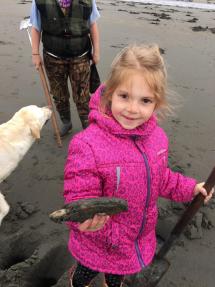ARCHIVED NEWS RELEASE
This document is provided for archival purposes only. Archived documents
do not reflect current WDFW regulations or policy and may contain factual
inaccuracies.
News release March 24, 2022
Dan Ayres, 360-249-4628 ext. 209
Public Affairs Contact: Mark Yuasa, 360-902-2262

OLYMPIA – Razor clam enthusiasts can head to four coastal beaches as shellfish managers with the Washington Department of Fish and Wildlife (WDFW) today, confirmed the next round of digging can proceed as planned from April 1-6.
"Diggers who take advantage of these spring morning tides will find plenty of razor clams that are fattening up for the late spring spawning period making for some tasty meals,” said Dan Ayres, the WDFW coastal shellfish manager.
Digging is allowed during low tide from 12:00 AM through 11:59 AM only:
- April 1, Friday, 7:36 AM; +0.5 feet; Long Beach, Twin Harbors, Mocrocks
- April 2, Saturday, 8:07 AM; 0.0 feet; Long Beach, Twin Harbors, Copalis
- April 3, Sunday, 8:45 AM; -0.1 feet; Long Beach, Twin Harbors, Mocrocks
- April 4, Monday, 9:23 AM; 0.0 feet; Long Beach, Twin Harbors, Copalis
- April 5, Tuesday, 10:01 AM; +0.2 feet; Long Beach, Twin Harbors, Mocrocks
- April 6, Wednesday, 10:43 AM; +0.5 feet; Long Beach, Twin Harbors, Copalis
Details on these and future digs can be found on the WDFW razor clam webpage.
Not all beaches are open for every dig, so diggers are encouraged to make sure their intended destination is open before heading out. Diggers should also continue to respect coastal communities and residents by following local and state health guidelines.
Under state law, a daily limit consists of the first 15 clams dug regardless of size or condition, and each digger’s clams must be kept in a separate container. The most successful digging occurs between one and two hours before the listed time of low tide.
For the most part success has been very good this past winter, and the recent 7-days of digging in mid-March generated near limits of clams on all four open beaches. An estimated 27,533 diggers took home 388,655 razor clams for an average of 14.1 razor clams per digger.
Now that spring has arrived, Washingtonians should purchase their 2022-2023 recreational fishing or shellfishing licenses before current licenses expire after March 31. Anyone digging razor clams beginning April 1 will need a new license to participate. All diggers age 15 or older must have an applicable fishing license to harvest razor clams on any beach.
As in past years, WDFW is asking beachgoers to avoid disturbing nesting snowy plovers – a small bird with gray wings and a white breast – by staying out of posted areas along the Southwest Washington Coast. Snowy plover nests are nearly invisible, and it is vital to give these birds the space they need to live and thrive during their nesting period, especially near Midway Beach and the north end of Long Beach. People should avoid leaving leftover food or trash on the beach – which attracts predators – keep pets on a leash, and not to go into the dunes at all, which are clearly marked with posted signs. When driving on the beach, please respect the 25-mile per hour speed limit and enter only at designated access points. Be sure to stay on the hard-packed sand near or below the high tide line.
For helpful tips on how to clean and cook razor clams check out this WDFW YouTube link. Click here to find additional tips and razor clam recipes. To learn more about razor clam abundance, population densities at various beaches, and how seasons are set, visit the WDFW razor clam management webpage.
The Washington Department of Fish and Wildlife works to preserve, protect, and perpetuate fish, wildlife and ecosystems while providing sustainable fish and wildlife recreational and commercial opportunities.